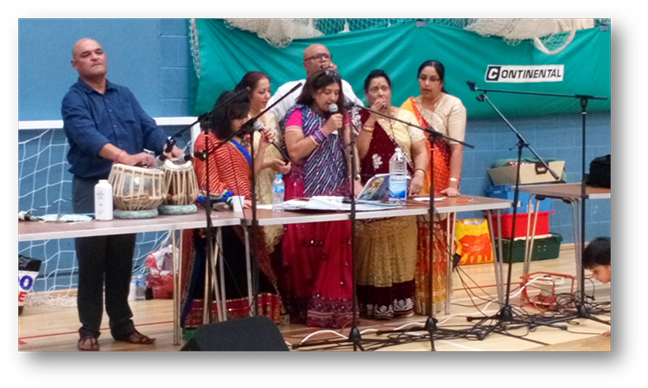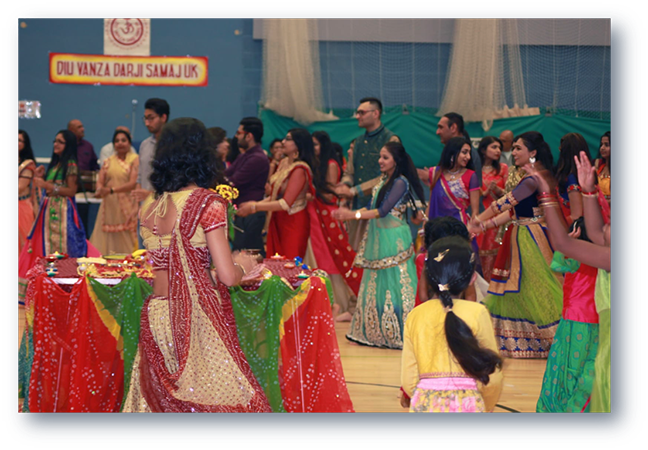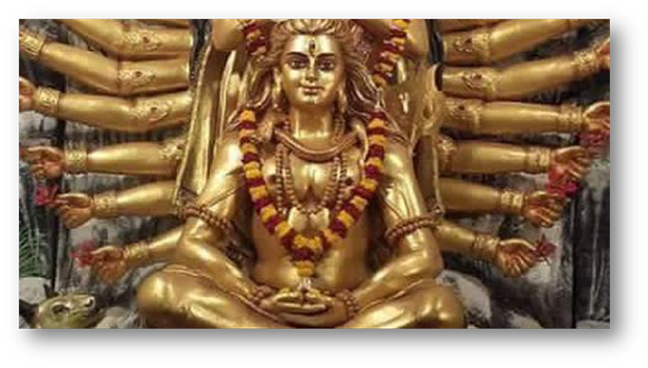Read this blog post in: Português | ગુજરાતી
Navratri is literally nine nights. The festival of Navratri is celebrated during the first nine days of Shukla Paksha of Ashwin. The tenth day is Vijayadashmi or Dassera.

In this photograph, one can see the performers of Garba songs and the musicians on the occasion of the celebration of Vijyadashmi held by Diu Vanza Darji Samaj UK. Photo courtesy Diya Dipac.

In this photograph, one can see the Garba on the occasion of the celebration of Vijyadashmi held by Diu Vanza Darji Samaj UK. Photo courtesy Sunny Narendra.
The festival of Navratri is indeed hallowed and venerable. This lasts for nine days and involves performances of daily rituals, spiritual practices and worshipping of the goddesses. It is universally accepted that although known individually as Durga, Kali, Sarasvati, and Lakshmi, they simply represent different forms of Shakti, the primordial cosmic energy, the divine feminine creative power.
Ancient sages have narrated the union of Shiva with Shakti. Shakti represents the primordial cosmic energy responsible for the processes of creation and destruction that occur unceasingly. The foundation of Shiva is the all-pervading Supreme Consciousness, without which even Shakti cannot function. The great sages named this primordial cosmic energy as Devi – the one who creates, preserves and destroys.

Shiva and Shakti, a cosmic union for creation.
This primordial cosmic energy is all-pervasive and is present even in the human body where it is referred to as the kundalini. This lies dormant in the mooladhara chakra – which is situated in the subtle body, not the gross visible body. This dormant primordial energy residing in the mooladhara chakra is symbolised by a red coloured inverted triangle. As long as this energy remains dormant, the human life cannot evolve, cannot attain greater heights.
Yoga, especially raja yoga, chakra yoga detail the various practices required to awaken this dormant energy. This primordial energy resides in the mooladhara chakra, whereas Shiva resides in the sahasrara chakra (at the top of the head). Until and unless a union takes place between Shakti and Shiva, human life lacks spiritual awakening and upliftment. In most humans, this union does not occur in their lifetime and they live their lives at a very low level of consciousness. And the transformation that happens in a person’s life when the kundalini gets awakened is phenomenally remarkable. It is like the perishable mortal body metamorphoses into the form of Shiva.

In this photograph, one can see the aarti being performed by the Samaj members on the occasion of the celebration of Vijyadashmi held by Diu Vanza Darji Samaj UK. Photo courtesy Sunny Narendra.
Science differentiates between matter and energy. However, tantra regards this as one and the same – matter is the gross form of energy and energy is the subtle form of matter. The divine essence of this energy is called Shakti. One cannot attain spiritual evolution without the presence of Shakti. Needless to say, as long as this energy is not awakened and remains dormant, a human life is no better than that of an animal. If one lives in fear, perpetually seeking sensual gratification, sleep and lethargy despite having a human body, it is then indeed comparable to the existence of an animal.
It is for the awakening of this very energy that the ancient sages described this spiritual practice and worship for a period of nine days. For all nine days, devotees of the Devi observe fasting, perform spiritual practices and rituals to lead a virtuous life.
It is perfectly alright to house and worship an idol of Devi Durga. However, bearing in mind that as long as one does not take efforts to awaken the inner primordial cosmic energy, one will be unable to comprehend the profound spiritual significance of Navratri. The mysterious, abstruse significance can only be fathomed by the one for whom the virtuous way of living is not restricted only to Navratri but is adopted for the entire lifetime.
Shakti and Shiva are incomplete without each other. This entails then that unless the Shakti inherent within us is awakened, and until it ascends upwards piercing all the chakras and merges with Shiva at the sahasrara, Shakti cannot be the source of bliss and wisdom.
The nine days of Navratri are an opportunity to perform and observe the spiritual practices for the awakening of Shakti. The importance of this should sink within all of us so that we realise that if our entire life’s pursuit is just about sensual gratification and fulfilment of worldly desires then we have not as yet known the essential nature of Devi Durga.
Post by Dipac Canacsinh
Acknowledgements
I am deeply grateful to Mr. Pradip Vassantlal for his exceptionally helpful feedback provided on the Gujarati version of this article.
I would like to express my sincere gratitude to Sunny Narendra and Diya Dipac for providing me with the photographs used in this article.

